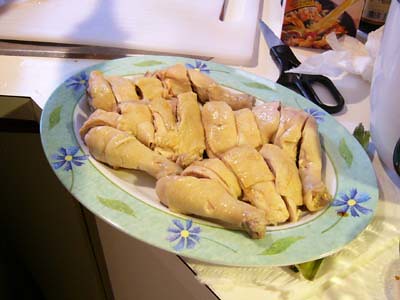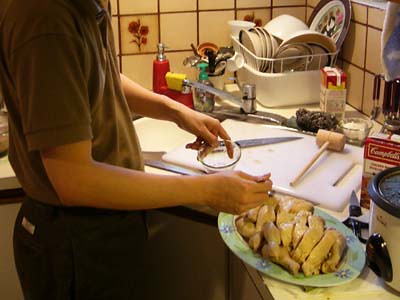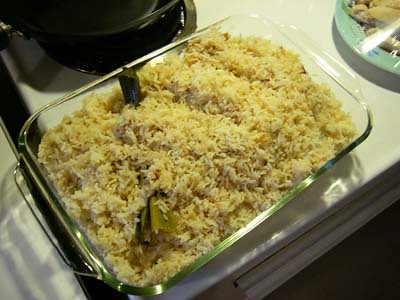Hainanese Chicken Rice (homemade)
Traditionally, you are supposed to deal with whole chickens--but since I do not like chicken-breast meat, the following recipe uses chicken legs instead. I know of slightly more complicated recipes that include the use of spices such as cinnamon and cloves, but this is strictly a simple, "home-made" affair; and it has never failed me before. Last successfully made Feb 17, 2004.

(Note: measurements are purely approximates)
The chicken: take 8 Chicken legs (incl. thighs), clean with water, wipe clean. Cut off excess fats, set aside (the fats, that is). Add a piece of ginger (1"), some sprigs of spring onions and two (whole) pandan leaves to a large pot of water (enough to submerge all the chicken); bring to a brisk boil. Put chicken into the pot and continue boiling for just over 5 min. Turn off the heat, cover, for another 25-30 min (give or take, depending on just how much chicken there is; test by sticking a fork into the chicken--if it goes clean through without trouble, it's cooked). Remove chicken from pot and place in cold water (some people use ice water) for a few minutes. Keep stock for the rice and soup (below). Drip chicken dry (or wipe dry). At this stage, some would brush the skin with a little oil (sesame oil), but I suggest holding off. Cut into bite size first, lay out on the serving plate, then drip with soya sauce plus sesame oil (below picture). Sprinkle some chopped spring onions and coriander on top and serve.

The rice: The key is in the chicken fats cut from the meat earlier. Experience says about an 1+" lump (give or take) of fats to every cup (450ml) of rice. Use long grain white rice. Heat a bit of vegetable oil (I always use olive oil) in a frying pan (or wok, but I strongly recommend something non-stick); add chicken fats to melt down (be careful of the hot oil splatter). Once the most of the fats is melted down, remove the dredges. Fry some minced or ground ginger and garlic until fragrant. Add (uncooked, dry) rice; stir to make sure that the grains are covered with the oil. Once some of the grains turn opaque, it's time to remove the rice from heat. Put the oil fried rice in a rice cooker. Add pandan leaves (roughly one whole leave for every cup), and a dash of salt (or garlic salt). Add the appropriate amount of chicken stock (left from cooking the chicken, you might consider skimming some of the excess oil first)--e.g., in the usual rice to water proportion as required by the rice cooker. Set to cook. (Stirring at some point after most of the water is no longer visible is recommended to prevent the bottom from charring.) Canned chicken broth is perfectly fine for this recipe, but soup base powder has a distinct taste that may be too obvious, or "artificial" to some palettes.
As my rice cooker can only handle two cups of (uncooked) rice at a time, I had to do two rounds to make as much chicken rice as shown below. You can still see the pandan leaves:

Soup: I have my own variations on this one, which may not be the same as what they serve in the hawker centers. Take the chicken stock left from cooking the meat, skim off the excess oil floating on top; add a little more spring onions, some cut carrots, a tomato (quartered), some szechuan pickled vegetable (it's a pickled "chinese radish" actually), small soft tofu cubes. Cook over a low to medium heat until the tomatoes are soft (and a slightly tangy taste is added to the soup), and the various flavors from the other additions are incorporated into the soup. Add salt and pepper to taste, serve with freshly chopped spring onions sprinkled on top.

(Note: measurements are purely approximates)
The chicken: take 8 Chicken legs (incl. thighs), clean with water, wipe clean. Cut off excess fats, set aside (the fats, that is). Add a piece of ginger (1"), some sprigs of spring onions and two (whole) pandan leaves to a large pot of water (enough to submerge all the chicken); bring to a brisk boil. Put chicken into the pot and continue boiling for just over 5 min. Turn off the heat, cover, for another 25-30 min (give or take, depending on just how much chicken there is; test by sticking a fork into the chicken--if it goes clean through without trouble, it's cooked). Remove chicken from pot and place in cold water (some people use ice water) for a few minutes. Keep stock for the rice and soup (below). Drip chicken dry (or wipe dry). At this stage, some would brush the skin with a little oil (sesame oil), but I suggest holding off. Cut into bite size first, lay out on the serving plate, then drip with soya sauce plus sesame oil (below picture). Sprinkle some chopped spring onions and coriander on top and serve.

The rice: The key is in the chicken fats cut from the meat earlier. Experience says about an 1+" lump (give or take) of fats to every cup (450ml) of rice. Use long grain white rice. Heat a bit of vegetable oil (I always use olive oil) in a frying pan (or wok, but I strongly recommend something non-stick); add chicken fats to melt down (be careful of the hot oil splatter). Once the most of the fats is melted down, remove the dredges. Fry some minced or ground ginger and garlic until fragrant. Add (uncooked, dry) rice; stir to make sure that the grains are covered with the oil. Once some of the grains turn opaque, it's time to remove the rice from heat. Put the oil fried rice in a rice cooker. Add pandan leaves (roughly one whole leave for every cup), and a dash of salt (or garlic salt). Add the appropriate amount of chicken stock (left from cooking the chicken, you might consider skimming some of the excess oil first)--e.g., in the usual rice to water proportion as required by the rice cooker. Set to cook. (Stirring at some point after most of the water is no longer visible is recommended to prevent the bottom from charring.) Canned chicken broth is perfectly fine for this recipe, but soup base powder has a distinct taste that may be too obvious, or "artificial" to some palettes.
As my rice cooker can only handle two cups of (uncooked) rice at a time, I had to do two rounds to make as much chicken rice as shown below. You can still see the pandan leaves:

Soup: I have my own variations on this one, which may not be the same as what they serve in the hawker centers. Take the chicken stock left from cooking the meat, skim off the excess oil floating on top; add a little more spring onions, some cut carrots, a tomato (quartered), some szechuan pickled vegetable (it's a pickled "chinese radish" actually), small soft tofu cubes. Cook over a low to medium heat until the tomatoes are soft (and a slightly tangy taste is added to the soup), and the various flavors from the other additions are incorporated into the soup. Add salt and pepper to taste, serve with freshly chopped spring onions sprinkled on top.

10 Comments:
Ah chicken rice, every expat singaporean's dream meal. I'd like to say this... DON'T SCRIMP ON THE SESAME SEED OIL!
Yes! And if possible, go for one of the Singaporean brands--Chee Seng or Xing Long (pinyin)--they are still the best. We found Chee Seng in Toronto Chinatown and bought it immediately, even though it was the most expensive of the whole range on the shelf.
This looks so tasty. I would love to try it. But how do you cut the cooked chicken so firmly? Any tips?
I use a chooper and a (wooden) bludgeon--since I'm not confident enough to just chop. Rather, I position the chopper and pound on it using the bludgeon. Amateurish but it works...
Hihi
Thanks v much for the recipe. I juz had the chicken rice. V well done. We are perfecting the rice as we used brown rice so it went a little overcooked. hehe...
booooo
I agree that the sesame oil has to come from Singapore. We make the best ones. And see that like the rest of us stuck outside the country, you have to make your own chicken rice LOL. Looked like a great attempt!
why is the rice kind of colored? i've seen some with greenish ones. i'd like mine to be colored too. what do you suggest?
have you heard of hainan chicken rice where the chicken is steamed instead of boiling/poaching
Thank you for this recipe. Only one I had was from Her World '79. No joke! None of my aunts want to give up their Ellice Handy cookbooks.Is frozen pandan leaf as effective? My mum is Eurasian and we had pineapple tarts every X'mas and Easter. Good memories of all them making the tarts in Grandma's kitchen :)
Post a Comment
<< Home